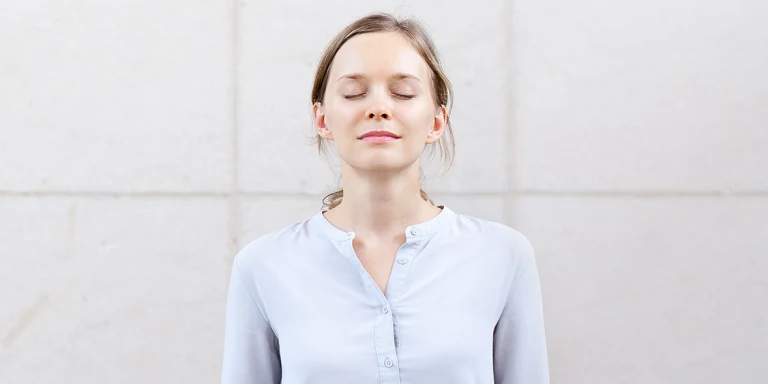
How progressive muscle relaxation works
Progressive muscle relaxation offers deep relaxation that counters stress, pain, sleeping disorders and many other ailments and also helps to prevent them. Beginners can find the right exercise here.
What is progressive muscle relaxation (PMR)?
Progressive muscle relaxation is a proven method for achieving full-body relaxation. The method can be ascribed to the American doctor Edmund Jacobson. As far back as 100 years ago, Jacobson presented the first research results on this relaxation technique. Today, there are several studies on its impact on health.
How does progressive muscle relaxation work according to Jacobson?
The principle is simple: you briefly and deliberately tense certain muscle groups one by one and release them abruptly. Following the tension, you experience the subsequent relaxation in a more intense and conscious manner. With each muscle group you apply the technique to, the feeling of relaxation spreads further throughout your body. Your blood pressure falls, your pulse slows and your breathing becomes calmer.
Preparation:
Sit upright with your feet on the floor. Either close your eyes or leave them open – whichever is more pleasant for you. Relax everything and breathe calmly, including during the exercises.
Process:
Maintain the tension in the specific muscle group for five to seven seconds before abruptly releasing it and relaxing for 15 to 20 seconds. Repeat each individual sequence twice. You may feel sensations such as warmth or tingles. Remain in a state of relaxation. End: stretch out, take a deep breath and open your eyes. Can you feel the deep relaxation?
- Hands and forearms
Form your right hand into a fist and bend your arm until the muscle tension becomes clearly palpable. Hold this position for five to seven seconds, release the tension abruptly and feel the effects. Repeat this twice on your right, twice on your left and then twice with both arms at the same time. - Face muscles
Frown, bite gently on your teeth and press your lips together. Hold this position, release it again and feel how the sense of relaxation spreads.
- Shoulder and neck area
Raise your shoulders in the direction of your ear lobes and remain sitting upright. Hold – release. Feel the relaxation in your neck and shoulders and continue to relax.
- Abdominal muscles
Pull your belly button inwards and keep your muscles tensed. Release and relax. Feel how the relaxation spreads.
- Legs and buttocks
Press your gluteal muscles together and tense both legs: tense your thighs, press your heals against the floor and lift your toes upwards. Release and feel the sense of relaxation.
When does progressive muscle relaxation help?
The relaxation technique helps to counter many physical and psychological ailments such as:
- chronic pain
- fear
- sleeping disorders
- stress and the consequences of stress (tension)
- depression
- mood fluctuations
- headaches
- high blood pressure
The targeted muscle relaxation also serves as a preventive measure. It improves your personal skills in handling stress, makes you emotionally resilient, leads to inner peace and resolves mental tensions and fears.
Avoid progressive muscle relaxation if you suffer from myositis or tendinitis and consult with your doctor if you have mental illnesses.
Stress isn’t always a bad thing: it spurs us on to do our best and releases endorphins. But it can also be overwhelming and make people ill. When does stress become a burden? How do we recognise stress symptoms and stay calm in difficult situations? Read now!
How quickly does progressive muscle relaxation work?
There are people who already experience the positive effects of the relaxation after only a short time. Generally speaking, the learning phase lasts eight to 12 weeks. Your body and mind need time until the feeling of relaxation appears ever more promptly. Experienced individuals are able to perform PMR on a purely mental basis and use it in any situation – without visibly tensing their muscles. The more regularly that you practice progressive relaxation, the more effective it is.
How often should you perform progressive muscle relaxation?
Ideally, beginners should be introduced to the technique by a qualified person over eight to 10 lessons. They can address your individual situation and any questions you may have. A new muscle group is added every week. The process thus becomes automatic. What is important is also that you practice regularly. At the beginning, it pays off to take 10 to 20 minutes each day for it so that it transfers to becomes part of your everyday routine. After all, your muscles are able to learn – with time, they can relax in a matter of seconds and thus become more resistant to stress.
For who is progressive muscle relaxation suitable?
Progressive muscle relaxation is suitable for everyone. Only in cases in which individuals suffer from serious mental illnesses should the doctor providing treatment be consulted. As this technique places relatively low demands in terms of attention and concentration, it is also suitable for children and young people.
Which benefits does progressive muscle relaxation offer?
PMR is easy to learn and is not based on a particular ideology or complicated theory. There is also no need for tools such as mats and audio devices for the performance of the exercises, meaning they can be done anywhere. Those who have learnt the technique gradually as part of a course can immediately incorporate it into their everyday routine and internalise it ever more. PMR is thus an ideal relaxation technique for beginners and easier than meditation or autogenic training.

Dr Heinz-Edwin Truffer (psychosomatician, Swiss Medical Association (FMH) specialist for psychiatry and psychotherapy) is medical director of the medrelax School for Relaxation Medicine in Zurich. He trains relaxation experts in progressive muscle relaxation, autogenic training and mindfulness techniques. Dr Heinz-Edwin Truffer was on hand to advise and support the editorial team for this article.


Newsletter
Find out more about current health issues every month and get all the information you need about our attractive offers from all Helsana Group companies * delivered by e-mail to read whenever it suits you. Our newsletter is free of charge and you can sign up here:
We did not receive your information. Please try again later.
* The Helsana Group comprises Helsana Insurance Company Ltd, Helsana Supplementary Insurances Ltd and Helsana Accidents Ltd.